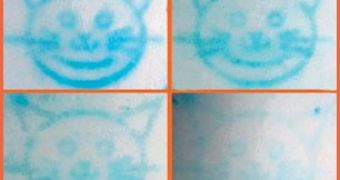Australian scientists have designed an enzyme printing process that produces bioactive paper by only printing the product of an enzyme-catalyzed reaction instead of the molecule itself.
Wei Shen and colleagues from Monash University, Australia, were inspired by traditional printing (ink jet and thermal contact), so they used planographic and relief printing methods to print only the product of a reaction catalyzed by an enzyme (horseradish peroxidase or HRP, in this case).
One technique explored by the team involved the use of an ink jet printer to make a digitally-generated enzyme pattern on a flat printing plate.
When the touches the paper, an image is generated by the different surface chemistries of the plate.
Shen developed another method, in order to avoid the transfer of the enzyme molecules, based on the immobilization of HRP on a nitrocellulose film to form the printing plate.
The paper is then coated with a liquid that changes color on contact with HRP, and when the printing plate is pressed against the paper, the biochemical reaction changes the color of the paper at the point of contact.
The whole idea behind the printing of the reaction instead of the molecules itself is that as long as the enzyme remains active, it can be reused.
Today's enzyme printing techniques use an 'ink' that contains the enzyme for biosensing, but once the enzyme has been transferred from the printer onto the paper in the ink, it is very hard to recover and reuse it.
Also, the enzyme could affect any other reactions that might occur on the paper, RSC reports.
The team of researchers “demonstrated the flexibility of their approach by using non-contact printing (ink jet) to pattern their printing plate,” according to Brian Derby, a specialist in biomaterials from the University of Manchester, UK, who adds that “this is a very clever piece of lateral thinking”.
This new type of printing “has potential applications in novel packaging materials, low-cost diagnostics, food safety, anti-counterfeiting, and pathogen detection using bioactive papers,” Shen explained.

 14 DAY TRIAL //
14 DAY TRIAL //